In May 2013 the renowned RHS Chelsea Flower Show celebrated its centenary and once again gave us a wonderful spectacle of horticulture and garden design at its best. But do flower shows such as Chelsea influence the way we design our gardens, or is it just theater by the garden design elite?
We might not mirror the gardens the designers create, but without doubt we are influenced by changing garden trends and fashions born at shows such as Chelsea. Even in my small garden, these trends and fashions from over the years can be found woven in its design and plantings. Since starting my new garden in Devon, England, nearly seven years ago, I have been influenced by the contemporary garden design that I've seen at the Chelsea Flower Show. From the overall style of my garden to the choice of the plant material, I have been influenced by the trends seen at the world's most famous flower show.
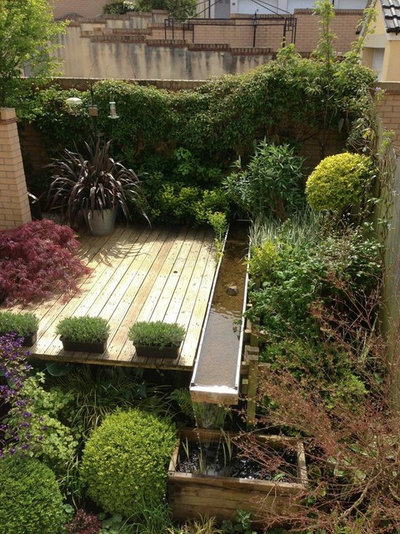
Small gardens are not easy to design, as they can easily look cluttered and busy. Show garden design tends to be very structured, with strong lines and simple shapes balanced with soft plantings.
My garden is small at 30 by 30 feet, so it was vital that the design was simple and practical, based on those strong lines, as in the wood rill and the simple rectangular deck.
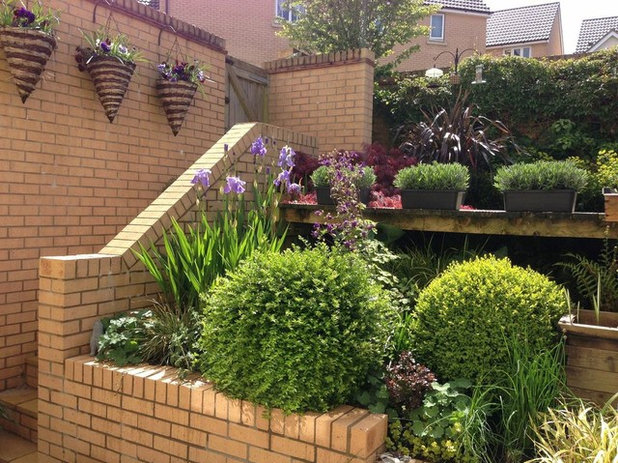 Topiary balls.
Topiary balls. Topiary balls, mainly using boxwood, have been a favorite of designers at Chelsea in recent years. I first saw them used en masse in Diarmuid Gavin's 2005
Hanover Quay Garden, where the entire garden was planted with 2-foot-diameter, closely clipped boxwood balls set in a sea of flowering lavender. He later reused the clipped balls in his 2008
Cafe Garden
.Chelsea in 2012 again saw the use of topiary balls in many gardens, including Thomas Hoblyn's Arthritis Research U.K. Garden.
I have grown my boxwood balls from small pot-grown plants, as they can be expensive to buy as specimens.
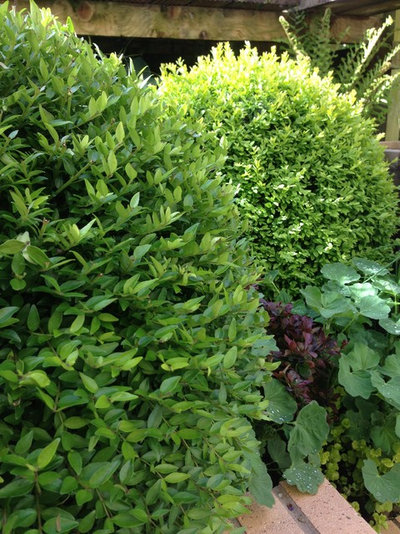
Though I have used mainly boxwood balls, the ball in the foreground of this image is
Lonicera pileata, which is a shrubby honeysuckle. It is evergreen but tends to be a bit more rampant than boxwood, so it needs more clipping in the growing season. It makes a good substitute for boxwood, as it doesn't suffer from box blight, which can be a problem in some countries.
Other evergreens that have been used at Chelsea for topiary balls include
Osmanthus x
burkwoodii; Hoblyn used it in the previously mentioned garden.
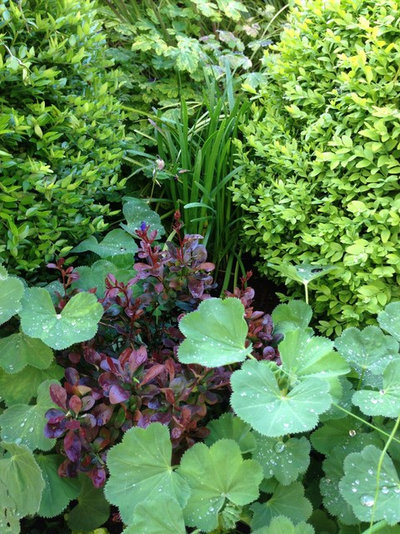 The "new English" style.
The "new English" style. The lower planted border here follows the "new English" style that we have seen at Chelsea in gardens such as Andy Sturgeon's
2012
M&G Investments Garden.
The clipped evergreen balls give structure while being underplanted by a mixture of grasses, herbaceous perennials, small shrubs and herbs. These are allowed to naturally intermingle, producing a tapestry of color throughout the growing season.
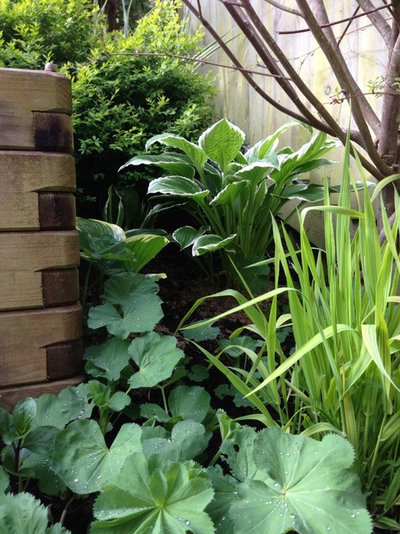 Cloud-pruned boxwood.
Cloud-pruned boxwood. One of my larger boxwood balls has been allowed to return to a more natural shape and is now cloud pruned following the methods used by the Belgian garden designer Jacques Wirtz.
I first saw this feature in Tom Stuart-Smith's
Laurent-Perrier Garden at Chelsea in 2010.
The foreground planting is mainly of hostas, enjoying the moist, shady spot at the foot of the raised wooden pool. The hostas have been interplanted with grasses to give a mixture of shape and texture that's reminiscent of contemporary show garden planting.
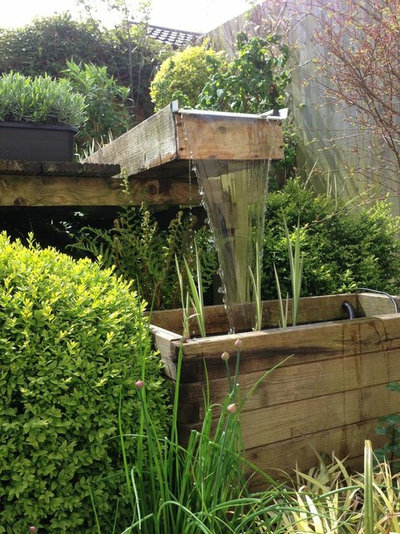 Water features.
Water features. Most show gardens include a water feature of some kind, and in the past few years they have tended to be formal and plant free, designed to mirror the surrounding garden.
I've used these ideas in my garden with a narrow rill that edges the deck and then falls in a sheet into a simple wooden pool below. It serves more than just a decorative purpose; being shallow, it provides a perfect drink station for wildlife, and it is great for cooling bottles of beer when I'm having a barbecue.
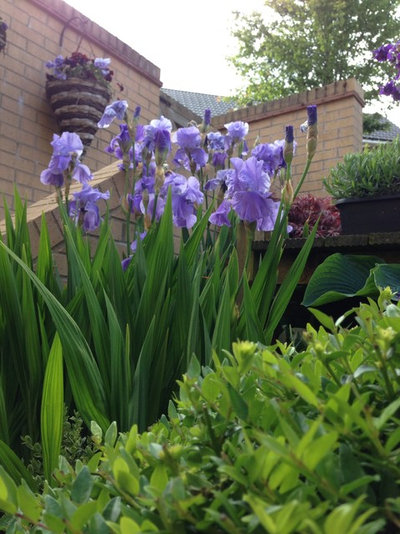 Iris germanica.
Iris germanica. The stately flowers of
Iris germanica, the bearded iris, have made it a firm favorite in recent Chelsea show gardens. This year they can be found in Susannah Hunter's and Catherine MacDonald's garden for the Massachusetts Office of Travel and Tourism, where they have used the beautiful purple variety 'Superstition'.
Planted in groups of the same color, they not only make a statement when flowering in early summer, but also earn their keep throughout the year with their spiky architectural foliage.
Planted in a run down the side of my deck, they balance out the rill on the other side as well as helping to lead the eye back into the garden. I chose a blue variety to reflect the deep blue skies that we get in a Devon summer.
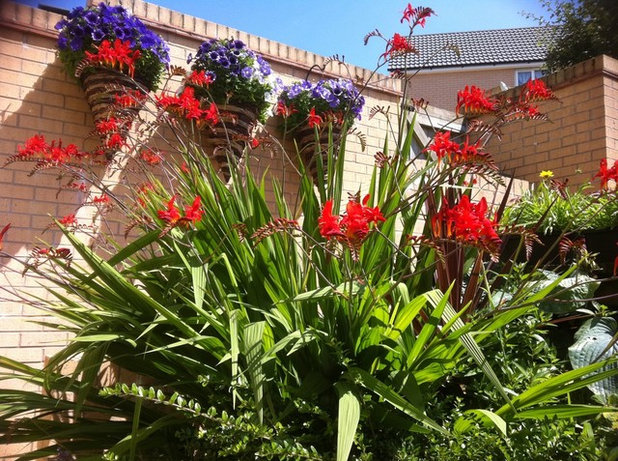 Exclamations of color.
Exclamations of color. As the
Iris germanica flowers fade, other flowers take their place. Above the green of the boxwood balls and lush new-English-style planting, the vibrant red flowers of
Crocosmia ‘Lucifer’ make a stunning exclamation mark.
This is another show garden design idea that I’ve borrowed from Chelsea; a strong color makes a statement among a mixture of foliage and pastel plants.
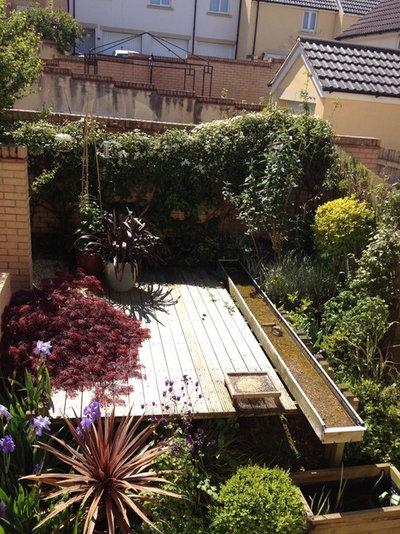 Green walls.
Green walls. The last idea I've brought back from Chelsea is that designers very rarely leave walls unclothed unless they are a design feature in their own right.
I am blessed with high walls on two sides of the garden, which provide not only privacy but also a great canvas for climbers and wall shrubs. Clothing the walls helps to make my small garden seem bigger.
I've layered my climbers, starting with
Clematis armandii 'Snowdrift' in early spring followed by
Clematis montana (shown here); then the rampant
Fallopia baldschuanica tries to fight its way through to give me a covering of white flowers through the summer.
Two other trends I love from the 2013 show. Of the many design and planting ideas from this year's show that I could transfer to my garden, two have caught my eye:
pillow-shaped topiary and
ornamental cow parsley.
Having extolled the use of evergreen topiary balls in gardens, including my own, I've really been blown away by the pillow-shaped
Buxus used by designer Robert Myers in his Brewin Dolphin Garden. I understand that the ball-shaped plants were frost damaged in the nursery and clipped back to a flattened pillow shape — the result is very stylish.
The white lacy flowers of
Anthriscus sylvestris 'Ravenswing' were used in Robert Myers' garden in his stunning planting of British natives, while Christopher Bradley-Hole
preferred to use
Orlaya grandiflora, the French cow parsley, in his
Daily Telegraph garden; he used them to contrast against large trimmed blocks of boxwood and yew.
This is how I want to use them in my garden — floating around and above my topiary balls and perhaps bringing a bit of the Devon countryside inside my garden walls.
Get more planting and design ideas in the Houzz Gardening section





